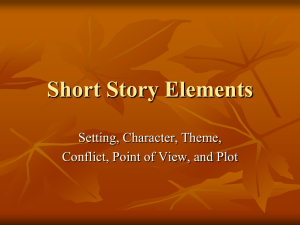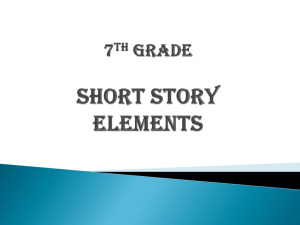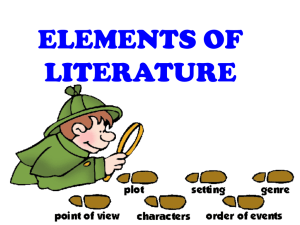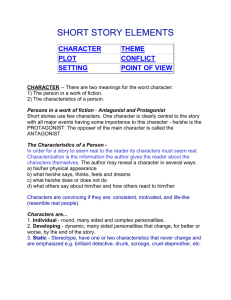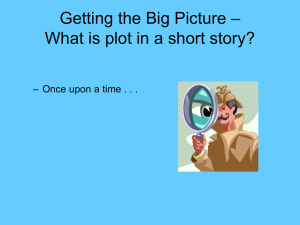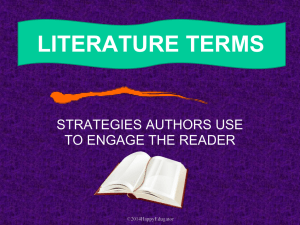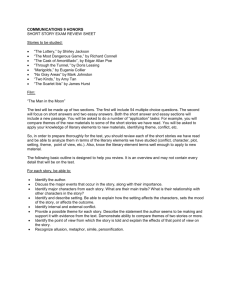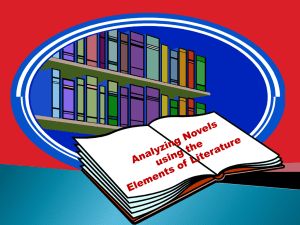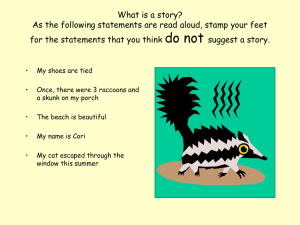Short Story Elements - Miss Lee`s Class Website
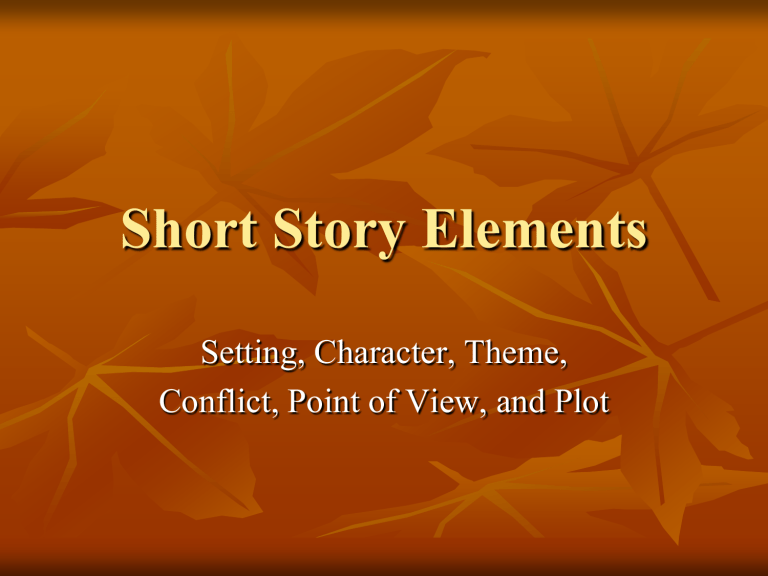
Short Story Elements
Setting, Character, Theme,
Conflict, Point of View, and Plot
Setting
The setting is the time and location in which a story takes place
There are several aspects of a story’s setting to consider when examining how setting contributes to a story: place, time, weather conditions, social conditions, mood or atmosphere
Setting
Place - geographical location
Time
– when the story is taking place (historical period, time of day, year, etc.)
Weather Conditions
– is it raining, sunny, stormy, etc
Social Conditions – what is the daily life of a character like, does the writing focus of speech, dress, mannerisms, customs, etc.?
Mood or Atmosphere
– what feeling is portrayed, bright and cheerful or dark and frightening?
Character
There are two meanings for the word character:
1) the person in a work of fiction
2) the characteristics of a person
Character
Persons in a work of fiction
Antagonist and Protagonist
Protagonist is the character at the center of the story with all the major events having some importance to this character
Antagonist is the opposer of the main character
Character
The characteristics of a person
In order for a story to seem real, the characters must seem real
The author must show the character is several ways
His/her physical appearance
What he/she says, thinks, feels, and dreams
What he/she does or does not do
What others say about him/her and how others react to him/her
Character
Characters are…
Individual
– round, many sided and complex personalities
Developing
– dynamic, many sided personalities that change, for better or worse, by the end of the story
Static – stereotype, have on or two characteristics that never change and are emphasized (brilliant detective, drunk, scrooge, cruel stepmother, etc.)
Theme
Theme is the story’s controlling idea or central insight. The author’s underlying meaning or main idea that he is trying to convey.
The title usually points to what the writer is saying and may use various figures of speech to emphasize the theme (symbol, allusion, simile, metaphor, hyperbole, or irony).
Theme
Common themes from literature, film and TV
Things are not always what they seem
Love is blind
Believe in yourself
People are afraid of change
Don’t judge a book by its cover
Conflict
Conflict is essential to the plot, without it there is no story
It is the opposition of forces which ties one incident to another and makes the plot move
Conflict
There are two types of conflict
1)
External
– a struggle with a force outside one’s self
2)
Internal
– a struggle within one’s self; a person must make some decision, overcome pain, quiet their temper, resist an urge, etc.
Conflict
1)
2)
3)
4)
There are four kinds of conflict
Man vs. Man (physical) – main character struggles with his physical strength against other men, forces of nature, or animals
Man vs. Circumstances (classical) – main character struggles against fate, or the circumstances of life facing him/her
Man vs. Society (social) – main character struggles against ideas, practices, or customs of other people
Man vs. Himself/Herself (psychological) – main character struggles with themselves; with their own soul, ideas of right or wrong, physical limitations, choices, etc.
Point of View
Defined as the angle from which a story is told
Innocent Eye - the story is told through the eyes of a child (their judgment being different from that of an adult)
Stream of Consciousness – the story is told so that the reader feels as is they are inside the head of one character and knows all their thought and reactions
Point of View
First Person – the reader sees the story through this person’s eyes as he/she experiences it and only knows what that character knows and feels (uses pronouns I, me, we, etc.)
Third Person - told by a narrator who is merely conveying a story, but not a character of any kind within the story being told (uses he, she, it, or they; but never as I or we [first-person], or you [secondperson])
Point of View
Limited Third Person - storytelling in which the narrator knows only the thoughts and feelings of a single character, while other characters are presented externally
Omniscient - author can move from character to character, event to event, having free access to the thoughts, feelings and motivations of his hcaracters and he introduces information where and when he chooses
Plot
Author arranges events to develop his basic ideas
Planned, logical series of events having a beginning, middle, and end
Exposition, Rising Action, Climax, Falling
Action, and Resolution
Plot
1)
2)
3)
Climax is a three-fold phenomenon
Main character receives new information
He/she accepts this information (realizes it but does not necessarily agree with it)
Then character acts on this information (makes a choice that will determine whether or not he/she gains his objective)
Bibliography
Ms. Engram http://hrsbstaff.ednet.ns.ca/engramja/elements.
html
About.com: fiction writing
